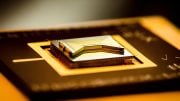
Researchers from MIT and elsewhere have recorded the “temporal coherence” of a graphene qubit — how long it maintains a special state that lets it represent two logical states simultaneously — marking a critical step forward for practical quantum computing.
For the first time, researchers from MIT and elsewhere have recorded the “temporal coherence” of a graphene qubit — that is, how long it can maintain a special state that allows it to represent two logical states simultaneously. According to the researchers, the demonstration, which employed a new type of graphene-based qubit, is a key step forward for practical quantum computing.
Superconducting quantum bits (qubits) are artificial atoms that use various methods to produce bits of quantum information, the fundamental component of quantum computers. Similar to traditional binary circuits in computers, qubits can maintain one of two states corresponding to the classic binary bits, a 0 or 1. But these qubits can also be a superposition of both states simultaneously, which could allow quantum computers to solve complex problems that are practically impossible for traditional computers.
The amount of time that these qubits stay in this superposition state is referred to as their “coherence time.” The longer the coherence time, the greater the ability for the qubit to compute complex problems.
Recently, researchers have been incorporating graphene-based materials into superconducting quantum computing devices, which promise faster, more efficient computing, among other perks. Until now, however, there’s been no recorded coherence for these advanced qubits, so there’s no knowing if they’re feasible for practical quantum computing.
In a paper published on December 31 in the journal Nature Nanotechnology, the researchers demonstrate, for the first time, a coherent qubit made from graphene and exotic materials. These materials enable the qubit to change states through voltage, much like transistors in today’s traditional computer chips — and unlike most other types of superconducting qubits. Moreover, the researchers put a number to that coherence, clocking it at 55 nanoseconds, before the qubit returns to its ground state.
The work combined expertise from co-authors William D. Oliver, a physics professor of the practice and Lincoln Laboratory Fellow whose work focuses on quantum computing systems, and Pablo Jarillo-Herrero, the Cecil and Ida Green Professor of Physics at MIT who researches innovations in graphene.
“Our motivation is to use the unique properties of graphene to improve the performance of superconducting qubits,” says first author Joel I-Jan Wang, a postdoc in Oliver’s group in the Research Laboratory of Electronics (RLE) at MIT. “In this work, we show for the first time that a superconducting qubit made from graphene is temporally quantum coherent, a key requisite for building more sophisticated quantum circuits. Ours is the first device to show a measurable coherence time — a primary metric of a qubit — that’s long enough for humans to control.”
There are 14 other co-authors, including Daniel Rodan-Legrain, a graduate student in Jarillo-Herrero’s group who contributed equally to the work with Wang; MIT researchers from RLE, the Department of Physics, the Department of Electrical Engineering and Computer Science, and Lincoln Laboratory; and researchers from the Laboratory of Irradiated Solids at the École Polytechnique and the Advanced Materials Laboratory of the National Institute for Materials Science.
A pristine graphene sandwich
Superconducting qubits rely on a structure known as a “Josephson junction,” where an insulator (usually an oxide) is sandwiched between two superconducting materials (usually aluminum). In traditional tunable qubit designs, a current loop creates a small magnetic field that causes electrons to hop back and forth between the superconducting materials, causing the qubit to switch states.
But this flowing current consumes a lot of energy and causes other issues. Recently, a few research groups have replaced the insulator with graphene, an atom-thick layer of carbon that’s inexpensive to mass produce and has unique properties that might enable faster, more efficient computation.
To fabricate their qubit, the researchers turned to a class of materials, called van der Waals materials — atomic-thin materials that can be stacked like Legos on top of one another, with little to no resistance or damage. These materials can be stacked in specific ways to create various electronic systems. Despite their near-flawless surface quality, only a few research groups have ever applied van der Waals materials to quantum circuits, and none have previously been shown to exhibit temporal coherence.
For their Josephson junction, the researchers sandwiched a sheet of graphene in between the two layers of a van der Waals insulator called hexagonal boron nitride (hBN). Importantly, graphene takes on the superconductivity of the superconducting materials it touches. The selected van der Waals materials can be made to usher electrons around using voltage, instead of the traditional current-based magnetic field. Therefore, so can the graphene — and so can the entire qubit.
When the voltage gets applied to the qubit, electrons bounce back and forth between two superconducting leads connected by graphene, changing the qubit from ground (0) to excited or superposition state (1). The bottom hBN layer serves as a substrate to host the graphene. The top hBN layer encapsulates the graphene, protecting it from any contamination. Because the materials are so pristine, the traveling electrons never interact with defects. This represents the ideal “ballistic transport” for qubits, where a majority of electrons move from one superconducting lead to another without scattering with impurities, making a quick, precise change of states.
How voltage helps
The work can help tackle the qubit “scaling problem,” Wang says. Currently, only about 1,000 qubits can fit on a single chip. Having qubits controlled by voltage will be especially important as millions of qubits start being crammed on a single chip. “Without voltage control, you’ll also need thousands or millions of current loops too, and that takes up a lot of space and leads to energy dissipation,” he says.
Additionally, voltage control means greater efficiency and a more localized, precise targeting of individual qubits on a chip, without “cross talk.” That happens when a little bit of the magnetic field created by the current interferes with a qubit it’s not targeting, causing computation problems.
For now, the researchers’ qubit has a brief lifetime. For reference, conventional superconducting qubits that hold promise for practical application have documented coherence times of a few tens of microseconds, a few hundred times greater than the researchers’ qubit.
But the researchers are already addressing several issues that cause this short lifetime, most of which require structural modifications. They’re also using their new coherence-probing method to further investigate how electrons move ballistically around the qubits, with the aims of extending the coherence of qubits in general.
Reference: “Coherent control of a hybrid superconducting circuit made with graphene-based van der Waals heterostructures” by Joel I-Jan Wang, Daniel Rodan-Legrain, Landry Bretheau, Daniel L. Campbell, Bharath Kannan, David Kim, Morten Kjaergaard, Philip Krantz, Gabriel O. Samach, Fei Yan, Jonilyn L. Yoder, Kenji Watanabe, Takashi Taniguchi, Terry P. Orlando, Simon Gustavsson, Pablo Jarillo-Herrero and William D. Oliver, 31 December 2018, Nature Nanotechnology.
DOI: 10.1038/s41565-018-0329-2








Be the first to comment on "Physicists Record Temporal Coherence of a Graphene Qubit"